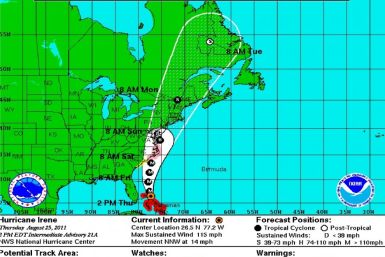As Irene moves in on North Carolina, NASA satellite photos shows its diameter is now about one-third the length of the whole U.S. Atlantic coastline.
New York City residents who live in low-lying areas should voluntarily start moving out on Friday, before Hurricane Irene is expected to hit, Mayor Michael Bloomberg said on Thursday.
North Carolina braced on Friday for a direct hit from Hurricane Irene, cities along the east coast were on alert and millions of beach goers cut short vacations to escape the powerful storm.
A state of emergency has been declared in six states toward the U.S. East Coast after Hurricane Irene caused havoc in the Bahamas.
U.S. Atlantic coastal residents from the barrier islands of North Carolina to the capital in Washington and the financial center of New York rushed to prepare on Thursday for an assault by powerful Hurricane Irene.
Hurricane Irene has left the Bahamas and is now churning toward the East Coast of the United States.
As Hurricane Irene headed for the U.S. East Coast Thursday night, authorities prepared for the worst and scientists said tides and ocean temperatures were increasing its destructive power.
New York City is prepared to shut down its entire mass transit system if necessary Saturday as it braces for Hurricane Irene, officials said Thursday.
The monster at this weekend's box office has nothing to do with the movies.
Hurricane Irene battered the low-lying Bahamas southeast of Florida on Thursday and now churns toward U.S. East Coast -- posing extreme danger to some of the country's largest cities.
Hurricane Irene which is approaching the East coast would have an impact not only on the coastal regions but also on the inland, U.S. officials warned on Thursday.
New Yorkers living in coastal areas are being warned to prepare for evacuation as Hurricane Irene seemingly heads straight for them. The exact path of the storm remains unclear, but meteorologists are increasingly predicting nothing short of a catastrophe for New York City.
Preparations begin for the hurricane.
In a bid to get ahead of Hurricane Irene that threatens to thrash the U.S. East Coast, New York declares a state of emergency, becoming the fifth state to do so.
A strengthening Hurricane Irene continues to move towards the U.S. East Coast, destroying some islands in the Bahamas along its path as it heads for the big cities. New York is the latest of five states to declare a state of emergency.
Ocean City activated phase three of its hurricane action plan and saw the evacuation of thousands of residents and visitors as officials made strict orders following Hurricane Irene's expected hit at the Maryland shore, while danger warnings were issued by Gov. Martin O'Malley of the monster storm.
Hurricane Irene is gearing up to be the biggest storm threatening to hit the New York metropolitan area in 26 years. Should Irene make landfall on Sunday with hurricane strength, it will be one of about five storms that have come within 75 miles of the city, according to data dating to 1851.
Hurricane Irene could end up closing refineries on the East Coast, which are concentrated in New Jersey and Pennsylvania, in anticipation for the storm's arrival, analysts say. Irene has been putting a beating down on the Bahamas for about two days. Structural damages, blocked roads and power outages have been reported in the southeastern islands.
Category 3 Hurricane Irene is gaining momentum and seemingly heading right for the city that never sleeps, and the potential exists -- in addition to risks to human life -- for major damage to New York's dwellings/infrastructure and economy.
Irene is expected to pass through Western Mass. Sunday night into Monday
Hurricane Irene continued its path of destruction towards the East Coast on Thursday -- posing extreme danger to some of the country's largest cities.
New Yorkers are preparing for Hurricane Irene, which threatens to become one of the biggest storms to hit the metropolitan area in decades. If Irene makes landfall in the New York area at hurricane strength, the powerful storm would be one of about five hurricanes to come within 75 miles of the city, according to records dating back 160 years.




































